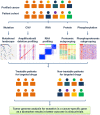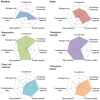Basic approaches, challenges and opportunities for the discovery of small molecule anti-tumor drugs
- PMID: 34249406
- PMCID: PMC8263657
Basic approaches, challenges and opportunities for the discovery of small molecule anti-tumor drugs
Abstract
Chemotherapy is one of the main treatments for cancer, especially for advanced cancer patients. In the past decade, significant progress has been made with the research into the molecular mechanisms of cancer cells and the precision medicine. The treatment on cancer patients has gradually changed from cytotoxic chemotherapy to precise treatment strategy. Research into anticancer drugs has also changed from killing effects on all cells to targeting drugs for target genes. Besides, researchers have developed the understanding of the abnormal physiological function, related genomics, epigenetics, and proteomics of cancer cells with cancer genome sequencing, epigenetic research, and proteomic research. These technologies and related research have accelerated the development of related cancer drugs. In this review, we summarize the research progress of anticancer drugs, the current challenges, and future opportunities.
Keywords: Drug therapy; cancer; comprehensive utilization; inhibitor.
AJCR Copyright © 2021.
Conflict of interest statement
None.
Figures





References
Publication types
LinkOut - more resources
Full Text Sources
Miscellaneous
